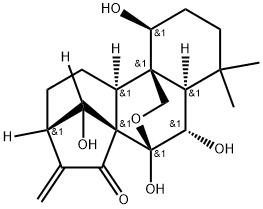???? C??? ??, ??, ??
??
Oridonin is a diterpenoid that has been found in
R. rubescens and has anti-inflammatory and anticancer properties. It is an inhibitor of AKT1 and AKT2 (IC
50s = 8.4 and 8.9 μM, respectively). Oridonin inhibits proliferation of KYSE70, KYSE410, and KYSE450 esophageal cancer cells in a dose-dependent manner, halts the cell cycle at the G
2/M phase, and induces apoptosis when used at a concentration of 20 μM. It decreases the expression of cleaved poly(ADP-ribose) polymerase (PARP), caspase-3, caspase-7, and Bim
s and the protein levels of phosphorylated AKT and reduces AKT activity. Oridonin reduces tumor growth in patient-derived mouse tumor models when administered at doses of 40 and 160 mg/kg. Oridonin is also an inhibitor of NLRP3 inflammasome assembly and activation. It inhibits inflammation in wild-type, but not
Nlrp3-/-, mice in a model of high-fat diet-induced type 2 diabetes when administered at a dose of 3 mg/kg.
??
Oridonin is an effective anticancer agent due to its ability to inhibit proliferation and induce apoptosis of human osteosarcoma cells. Blocks Wnt/β-catenin signalling.
Pharmacokinetics
The anti-inflammatory property of oridonin has been well documented in various immunological diseases. The compound is able to counteract the expression of COX-2 and NOS-2 in the murine RAW 264.7 macrophage cell line activated with LPS. The mechanism underlies the direct interference of the compound with the active region of NF-κB, thereby blocking its nuclear localisation and reducing inflammation (Leung et al., 2005). Shang et al. (2016) observed the efficacy of oridonin against RA-FLS proliferation. They found that oridonin inhibited cell proliferation and promoted cell apoptosis in IL-1β–treated FLS through phosphorylation of ERK1/2 and JNK in a dose-dependent manner. Oridonin is also reported to restrict the release of pro-inflammatory cytokines in LPS-activated RAW264.7 macrophages (Shang et al., 2016).
???
Oridonin has shown prominent adverse effects, even toxicity, under specific circumstances in vitro and in vivo. It showed hepatotoxicity and hepatoprotective effects, which the pair of pharmacological activities seems to be a paradox. However, through the analysis, it is found that this is mainly related to the concentration of oridonin and the time of administration. Long-term administration and high-dose administration may cause liver damage. On the other hand, according to the chemical structure of oridonin, it may react covalently with the sulfhydryl group of some proteins, which can partly explain the reason for adverse reactions, even toxicity of oridonin in specific environments[6].
???? ?? ?? ? ???
???
?? ??







